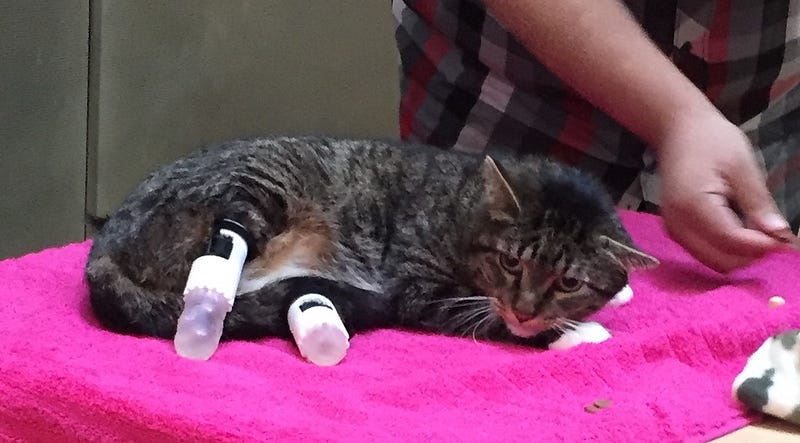A young cat, Sergeant Stubbs, lost both his hind legs last year in a train accident. Find out how first-year engineering students helped him lead a better life…

In recent years, rapid engineering innovations have created a symbiotic relationship between engineers and local and international communities that benefit from their inventions. For instance, innovations in the field of biomedical engineering are often geared towards helping machines efficiently interact with humans and animals. With the goal of making the lives of many amputees easier, prosthetics technology has advanced remarkably in the past two decades, with models that are more reliable, efficient, and lifelike than earlier versions — a feat driven largely by amputees’ demands.
The flexible, fast-paced world of engineering design churns out rapid innovations not only at a doctorate level, but even in first-year undergraduate classes at UW-Madison. As advancements in this field are applicable to both human and animal amputees, Professor Kathryn Kalscheur has adopted a unique approach to teaching engineering through InterEGR 170: Design Practicum class. In this class, first-year engineering students spend one semester solving a real-life problem presented to them by a client. “My role is to guide these students through the design process and help them get the resources they need to solve the problem. The students really take ownership of the project, which provides them with the best learning,” says Kalscheur. This semester, students took responsibility of quite a unique project on behalf of the Community Cat Rescue Team — fabricating prosthesis for Sergeant Stubbs, a young cat who lost both his hind legs last year in a train accident.
From brainstorming prototypes to fabricating the prosthetics at the MakerSpace on campus, students gained valuable experience of the engineering design process. “The goal of all of our projects is that the clients benefit from receiving a solution to their problem through the innovation and hard work of our engineering students, while the students benefit by getting experience working with a team to implement the design process with a real client,” says Kalscheur.
On the first day of class, students are presented with a variety of projects shortlisted by the instructor, most of which are for “people who have a unique need because of a disability, while some are custom-made devices for schools, farmers, researchers, and community groups,” explains Kalscheur. Before working in teams, students rank their projects based on their preference, and most are allotted their first or second choice. Most of the roles require good leadership skills. This means students get the best of both worlds — they learn to work independently, while gaining the experience of teamwork. “In our team, … all of us [choose] our own roles and work together towards an end result,” says Pierson Fisher, external communications manager of the Sgt. Stubbs project. “Students also present preliminary designs to the client, fabricate prototypes, write the final report, and present at the end-of-semester poster session,” says Kalscheur.
Projects undertaken in this class mostly involve the students, connecting them with the true meaning and experience of a career in engineering. However, designing prosthetics for an animal is considerably harder than doing so for humans due to limited input and feedback from animals. Nevertheless, it’s not entirely impossible to judge the animal’s response to the prosthetic. “What we have done is consulted professionals and tried to understand what has been done in the past, but that information is limited,” says Pierson. Keeping these challenges in mind, the team made significant advancements in learning and successfully applying the engineering design process.
“The first step in the process is defining the need,” says Kalscheur. “We began with a client consultation, specifically aiming to understand how Sgt. Stubbs is disabled. We found that his legs were different lengths, meaning different prosthetics served different purposes,” says Pierson, adding, “the next step was to size the prosthetics correctly, to make sure it will fit and stay on.” Most of the design process also involves generating multiple solutions by individual and group brainstorming. “[Design] is an iterative process where the generation of solutions and testing often requires going back to the research stage and further brainstorming of solutions,” states Kalscheur.
As the world of engineering design is constantly evolving, it is important to consider creating new and improved designs for prosthetics and other machines worldwide. As one of the goals of prosthetics is to be durable and easily replaceable, “… further refinements [on Sgt. Stubbs’ prosthetics] will be made as necessary and rapidly prototyped at the MakerSpace on campus,” claims Kalscheur. Compared to a standard first-year course, working on projects that directly impact the real-world is very rewarding and “a highlight of the [first-year] coursework,” according to Kalscheur. Aside from being a great opportunity for building professional skills and networking with the College of Engineering staff and students, “[these projects] show the community that college students can change lives,” says Pierson.
A team of first-year college students working towards brainstorming, designing, and fabricating prosthetics for a disabled cat only goes to reinforce the importance of engineering in the real-world. “The Accreditation Board for Engineering and Technology (ABET) defines engineering as a profession in which a knowledge of the mathematical and natural sciences, gained by study, experience, and practice, is applied with judgment to develop ways to utilize, economically, the materials and forces of nature for the benefit of [society],” says Professor Kalscheur. However, an engineer’s work is more than just repetitively producing technical solutions. The world is changing, now more than ever, and engineers lead this fast-paced change with each refinement, each upgrade, and each invention. The goal of engineers worldwide is to make the world more efficient and productive while also making it a great place to live. Every device an engineer lays their hands on, creates, or recreates not only affects the present, but also the future. Engineers don’t just sit back and watch. They make things happen.
